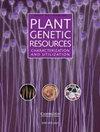毛刺草叶片形态、遗传分析及开花低温条件
IF 0.7
4区 生物学
Q3 PLANT SCIENCES
Plant Genetic Resources: Characterization and Utilization
Pub Date : 2023-07-28
DOI:10.1017/s1479262123000497
引用次数: 0
摘要
毛蕊花(Verbascum blattaria L.),俗称飞蛾毛蕊花,在美国归化,其花呈白色或黄色,可作为潜在的观赏植物。然而,利用分子标记和叶片形态的遗传特征、比色分析和低温处理影响下的开花情况,尚无研究来评估其作为潜在的园艺和景观植物的应用价值。莲座生长期发育的基生叶倒披针形,叶尖钝,叶缘有切口。在生殖发育过程中,茎上产生的叶片为卵形或披针形,叶尖钝或尖。在莲座生长阶段,不论叶柄和叶片的颜色如何,核糖体ITS和叶绿体间隔物的序列没有差异。所有植物都开出乳白色的花,基部花冠略带紫色。在营养发育和生殖发育过程中形成的叶片均无毛。在萼片、花梗和苞片中观察到许多有柄的腺毛。种子在25℃下10天开始发芽,播种后30天到达高原。低温处理20 d (20 CD)的植株在131 d开花最早,开花76朵,比低温处理0、40和60 d的植株开花数量最多。低温处理20 d的植株开花较早,从茎短到第一朵花可以判断,从营养生长到生殖发育的过渡较早。本文章由计算机程序翻译,如有差异,请以英文原文为准。
Leaf morphology, genetic analysis and low temperature requirement for flowering of Verbascum blattaria
Verbascum blattaria L., commonly known as moth mullein, naturalized in the USA that produces white or yellow flowers could be considered as a potential ornamental plant. However, genetic characterization using molecular markers and leaf morphology, colourimetric analysis and flowering of V. blattaria influenced by low temperature treatments was not investigated to evaluate as a potential horticultural and landscape plant use. The basal leaves developed during the rosette-growth stage were oblanceolate with an obtuse leaf apex and incisions at the margin. Leaves produced on the stem during the reproductive development were ovate or lanceolate with an obtuse or acute leaf apex. Regardless of the colour of the petiole and leaf blade during the rosette-growth stage, there were no differences in the sequences of nuclear ribosomal ITS and chloroplast interspacer. All plants produced creamy white flowers with a purplish base corolla. All leaves formed during the vegetative and reproductive development were glabrous. Numerous stalked glandular trichomes were observed in the sepal, pedicel and bracts. Seeds started to germinate in 10 days at 25°C and reached the plateau in 30 days after sowing. The earliest flowering occurred in 131 days when the plants received 20 days of low temperature treatment (CD) (20 CD), producing 76 flowers, the highest number compared to the number of flowers produced by plants that received 0, 40 and 60 CD. Plants that received 20 CD exhibited early flowering, probably because of the early transition from vegetative growth to reproductive development, as judged by the short stem to the first flower.
求助全文
通过发布文献求助,成功后即可免费获取论文全文。
去求助
来源期刊

Plant Genetic Resources: Characterization and Utilization
Agricultural and Biological Sciences-Agronomy and Crop Science
CiteScore
2.80
自引率
0.00%
发文量
29
审稿时长
>12 weeks
期刊介绍:
Plant Genetic Resources is an international journal which provides a forum for describing the application of novel genomic technologies, as well as their integration with established techniques, towards the understanding of the genetic variation captured in both in situ and ex situ collections of crop and non-crop plants; and for the airing of wider issues relevant to plant germplasm conservation and utilisation. We particularly welcome multi-disciplinary approaches that incorporate both a technical and a socio-economic focus. Technical aspects can cover developments in technologies of potential or demonstrated relevance to the analysis of variation and diversity at the phenotypic and genotypic levels.
 求助内容:
求助内容: 应助结果提醒方式:
应助结果提醒方式:


